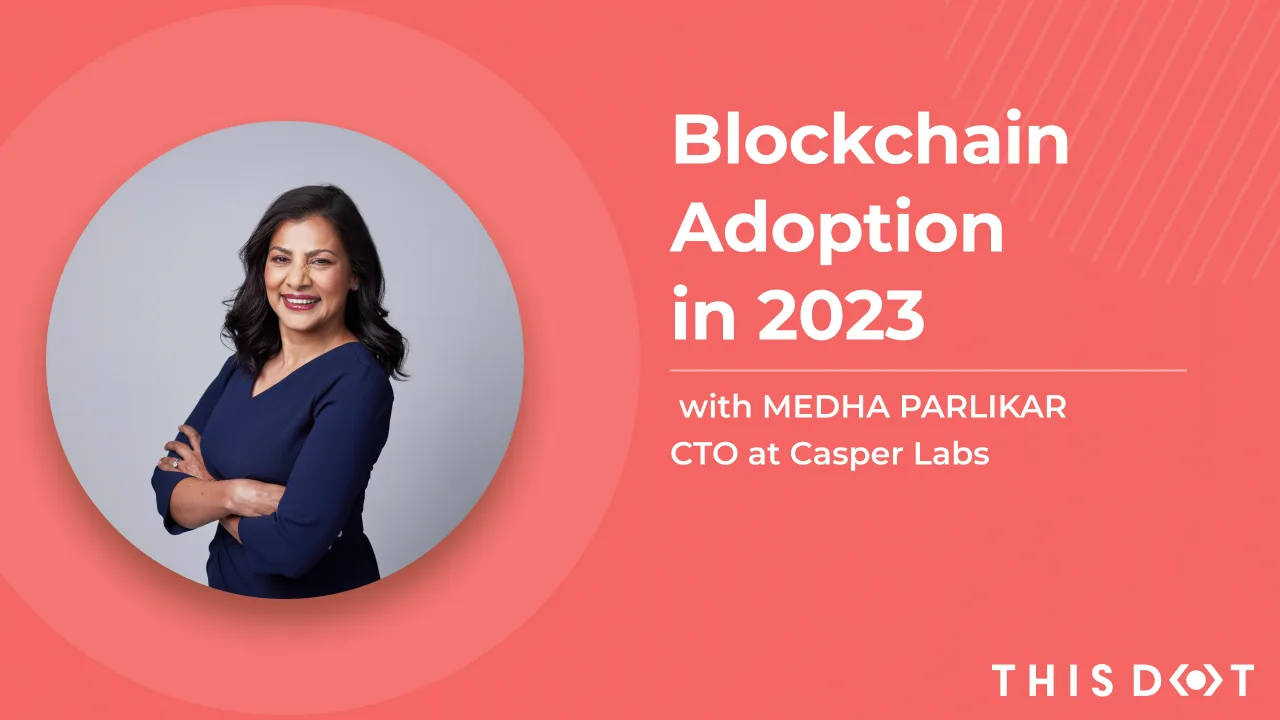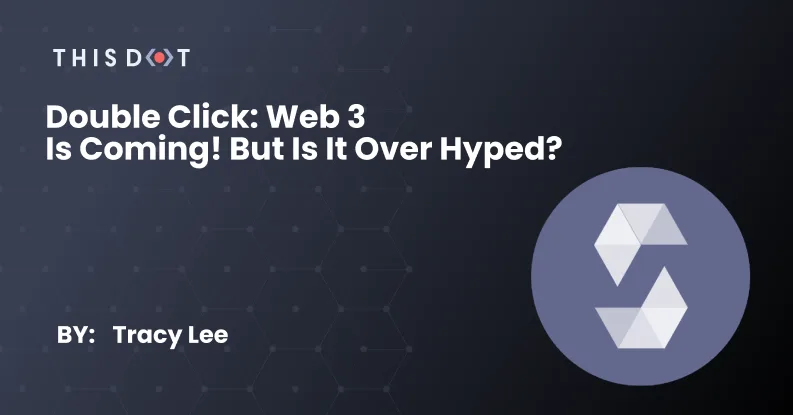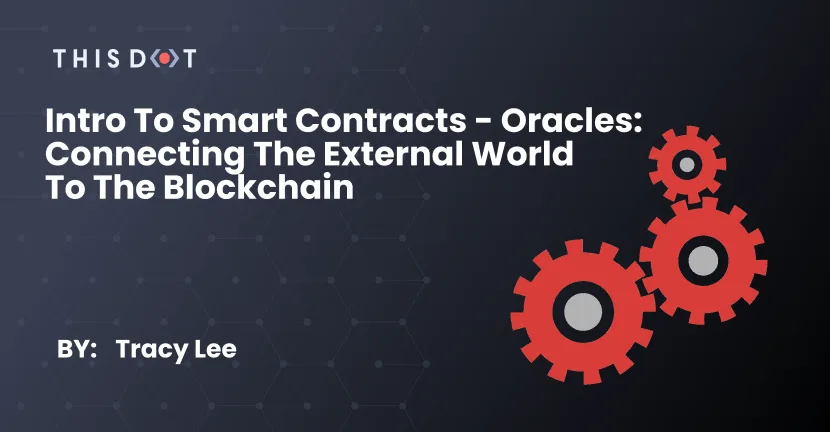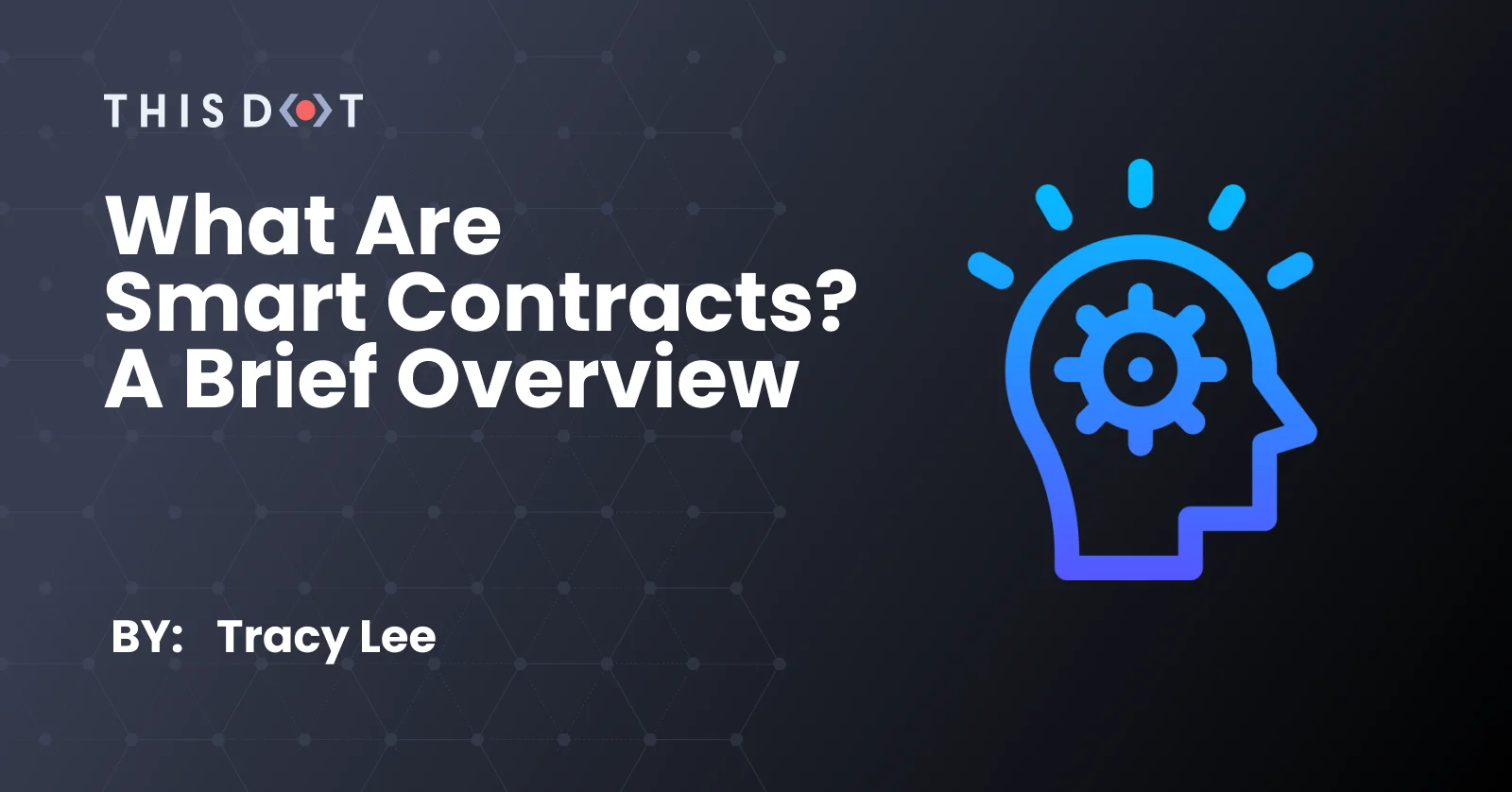Developer Insights
Join millions of viewers! Our engineers craft human-written articles solving real-world problems weekly. Enjoy fresh technical content and numerous interviews featuring modern web advancements with industry leaders and open-source authors.

Blockchain Adoption in 2023 with Medha Parlikar (Casper Labs) | Engineering Leadership
Tracy Lee hosts the Engineering Leadership Series and introduces Medha Parlikar, the Chief Technology Officer and co-founder of Casper Labs. Medha shares that Casper Labs has developed the technology behind the public Casper network, a decentralized blockchain protocol. Medha has a long history in technology, starting in the early 80s when she and her father built computers in their basement. She has been working in IT and personal computing ever since, transitioning into web 2.0 and eventually falling into the blockchain space in 2017. After a project she was involved in ran out of funds during the 2017 ICO crash, Medha co-founded Casper Labs with the aim of building a public decentralized blockchain technology that can be utilized by enterprises and brought to the masses. Tracy asks Medha about the evolution of blockchain and its buzzword status. Medha believes that adopting blockchain technology is similar to adopting cloud technology or the internet. She advises CTOs and CIOs to find someone who understands the technology and can guide them through the adoption process, comparing it to having a Sherpa. Companies like Red Hat, AWS, and VMware have played significant roles in leading and developing technologies like Linux and cloud computing. Medha emphasizes that blockchain adoption doesn't have to be daunting or scary. It can be approached incrementally, considering the risk-averse nature of enterprises. She encourages companies to proceed with caution and find trusted partners who can help them navigate the disruptive technology and its potential benefits. Tracy shifts the conversation to the challenges surrounding blockchain adoption. Medha explains that scalability, privacy, and regulatory uncertainty are common concerns. However, she believes that with proper planning and a trusted partner, enterprises can overcome these challenges. Blockchain technology holds great value and promise, and she encourages CTOs and CIOs to explore its potential benefits while mitigating risks. Medha shares her perspective on the role of blockchain in the enterprise. She believes that blockchain can provide transparency, trust, and efficiency in various industries, including supply chain management, finance, and healthcare. Blockchain has the potential to revolutionize business processes and enable new models of collaboration and trust. Tracy asks Medha about the role of education and awareness in promoting blockchain adoption. Medha acknowledges the need for education to bridge the gap between technical understanding and business requirements. She highlights the importance of explaining blockchain's benefits in a language that executives and decision-makers can understand. Medha also stresses the significance of community building and collaboration within the blockchain ecosystem. She encourages individuals and organizations to actively participate in communities, attend conferences, and engage in discussions to share knowledge, foster innovation, and drive the widespread adoption of blockchain technology. In conclusion, Medha Parlikar, as the CTO of Casper Labs, offers insights into blockchain technology adoption. She emphasizes the need for trusted partners, incremental approaches, and careful consideration of regulatory challenges. Medha envisions blockchain as a transformative force in various industries, and she encourages education, community building, and collaboration to drive its adoption forward. To watch the full conversation, check it out here....
Jul 14, 2023
3 mins

Double Click: Web 3 is Coming! But is it Over Hyped?
Welcome to the Double Click! This is the weekly blog series that shines a spotlight on emerging technologies, technological concepts, and community projects that enrich the JavaScript Ecosystem! This week, we're talking about all of the hype and controversy surrounding Web 3, or the future of the web. If you are just hearing about Web 3 for the first time, it is the concept that the "web" as we know it, will eventually be composed largely of decentralized applications and tokenized systems that allow users to engage in peer-to-peer interactions without the use of enterprise sites and services. I know this might seem vague, but it might make more sense if we consider that "Web 1" was the period of time when the internet consisted of usenets and message boards, and "Web 2" occured as enterprises began digital products to create an interfaceable internet. "Web 3" now refers to a potential future where most of our web interactions will be facilitated by machines and decentralized protocols rather than centralized services, such as those owned by banks and payment processors. I am extremely excited about the potential that blockchain technologies have to revolutionize the web as we know it. If you follow any of my recent blog posts, you will know that I am a huge proponent of decentralized applications, and even offer Solidity development services through This Dot Labs. That being said, developers who are just getting into the industry do not need to worry that all of their hard work learning JavaScript and frameworks was for naught. Though blockchain will only continue to grow in popularity and expand in functioning, we're not quite on the doorstep of a web revolution that will fundamentally change the sort of skills and expertise needed on the market. We will still need centralized applications, web sites, mobile applications, and more for quite a while. However, if you are interested in becoming an early blockchain adopter, there are tons of opportunities to become involved. With all of the Web 3 hype, there are hundeds of new projects and companies popping up with opportunities for developers. But if you aren't quite ready to make the full leap into this pioneering space, you can contribute to blockchain community projects, such as those offered by various networks and tokens, or building your own decentralized application. After all, JavaScript and Solidity use nearly identical syntax! But what do you think? Do you believe we're on the precipice of a great new web development revolution, or are you not quite buying the hype yet? Be sure to let me know by tweeting me at @ladyleet....
Oct 5, 2021
2 mins

Intro to Smart Contracts - Oracles: Connecting the External World to the Blockchain
A few weeks ago, I published my first blog post on smart contracts, introducing some basic definitions as well as how these decentralized apps function on the Ethereum blockchain. If you need a refresher, a smart contract is a distributed blockchain application that stores logic and executes actions when the conditions of a particular agreement are met. These contracts are built using languages like Solidity, which is one of the programming languages for developing decentralized applications. However, one limitation of using smart contracts is that they can only process information which exists on the blockchain, so in order for these applications to see wider adoption, blockchain developers needed to create a method for quickly and automatically recording and leveraging disparate information otherwise not stored on a network. This is where oracles come into play. A blockchain oracle is a piece of software- typically an API- that fetches information available on the web and reports that information to smart contracts on the blockchain. This information could include anything from world events: from changes in the stock market to that day’s dew point in San Francisco. Any information which a smart contract must depend on in order to function, but isn’t able to pull from the blockchain, might require the help of thousands of oracles, all reporting requested information so that the smart contract can execute on accurate, trustworthy, real-time data. This offers a number of advantages for industries looking to further automate their processes. For example, freight companies can code smart contracts that notify workers in a particular region when to take further precautions due to inclement weather. This decentralized app can automatically issue this warning without direct oversight by continuously pulling available weather data from oracles. We might also see an expansion of smart contract technology used in the medical field as well. Hospitals can automate medical supply ordering processes to respond to real-time changes in their stock or availability of stock, using oracles that can continuously update the smart contract with inventory and/or the volume of inventory currently available from suppliers. This can ensure that hospitals, especially during this difficult period, can reduce administrative overhead and ensure that they have the best chance at securing the supplies that they need. Of course, this use case is not unique to the medical field as this type of decentralized app could also benefit retailers or manufacturers who are constantly working to predict their supply needs against demand. Oracles can help combat the ever-present “bull-whip” risks, through which sharp increases in demand, followed by periods of lower demand, often leads to retailers and manufactures acquiring more inventory and raw materials than they truly need, by continuously updating automated ordering applications with second-by-second data on present demand. Chainlink, a network agnostic oracle platform, is the leading platform for connecting real-world data to the blockchain through oracles. It facilitates the transfer of tamper-proof data between the APIs drawing real world data from centralized locations on the internet and the smart contracts receiving and responding to that data. Similar to other networks, it issues its own ERC677 token, called LINK, and is used to compensate node operators that verify smart contracts executed on the Chainlink network, or can be used as any other ERC20-based token might be. To learn more about how you can build your own smart contracts on the Ethereum network while leveraging all of the information available on the web, reach out to This Dot Labs to connect with one of our Solidity experts! We can’t wait to hear your ideas!...
Sep 16, 2021
3 mins

What Are Smart Contracts? A Brief Overview
What are Smart Contracts? Simply put, smart contracts are distributed blockchain applications that store logic and execute actions when the conditions of a particular agreement are met. Ex: Imagine you owned a marketplace platform that allows individuals to list items for other users to purchase, but you are tired of having to manually address fraud claims when users purchase items that are not sent. You could code a smart contract that records payment from a buyer, and distributes payment to a seller once a receipt of successful delivery is reflected on the blockchain. In cases where sellers do not meet their obligation to ship within a stated time period, payment can automatically be returned to a user without the time, hassle, or costs of authorizing fraud claims yourself. Smart contracts, as we understand the term today, originated on the Ethereum network. Ethereum (not to be confused with its cryptocurrency, Ether) is a worldwide blockchain network that allows developers to deploy decentralized applications. When we say that these applications are “decentralized”, that means that the application, as well as all of the information it receives and outputs, are represented and recorded across a massive network of “nodes” or computers that simultaneously record information. The information is unchangeable, fully transparent, and accessible by all parties involved in the transaction, be it financial or otherwise. This promotes security, automation, and accurate record keeping for both developers and users. Smart contracts built on the Ethereum network use a language called Solidity. Fortunately, Solidity’s syntax is modeled after JavaScript’s, allowing developers with JS experience to quickly spin-up and deploy these applications with a relatively small learning curve. Additionally, Ethereum serves as the foundational network on which many other blockchain projects, including Chainlink, Aave, Axie, OpenSea, and UniSwap- to name just a few- are built. Though we have only just begun to exercise the capabilities of smart contracts, many are currently being used to automate interest payments for lenders, simplify and secure the crowdfunding process, and otherwise circumvent third party service providers that either process payments, or verify contracts on behalf of two or more parties. However, smart contracts have the potential to replace a number of financial and administrative processes that organizations currently outsource, manually process, or process using centralized applications and web architectures that often rely on third-party APIs anyway, and often lack comparable security, speed, and fraud protection. Deploying Your First Smart Contracts Deploying your first smart contracts is a critical step towards preparing your development infrastructure to compete in the modern digital marketplace. Teams should take advantage of this period of technological development to create simple smart contracts that demonstrate the advantages of leveraging these revolutionary applications within their organizations. For example, you could start by creating an employee survey application which anonymously records responses, and waits for a particular volume of responses before distributing them to the department which oversees these surveys. Or, you can create a charitable fundraiser which automatically matches employee contributions up to a certain threshold without ever needing to oversee these payments, or involve a third party financial institution. We’re Excited to Hear What You Have In Store! Do you have an idea for a game-changing smart contract, but need some extra help developing and deploying it? Reach out to This Dot Labs for a consultation, and we will be thrilled to help you see just how easily you can begin executing business logic on the blockchain!...
Aug 19, 2021
3 mins

Blockchain 2030: How Banks Can Plan for Global Blockchain Integration
A 2019 Gartner report forecasts the progress of blockchain technology over the next decade, defining the ‘20s as a period during which enterprises will shape the future of this technology by implementing their own small scale projects. These proof-of-concepts will largely handle internal processes, such as interdepartmental communication, financial transfers, and other operational procedures, as industries build the networks and infrastructures necessary to support a new global market, driven by this transformative technology. Over the next few years, banking sector expenditures are expected to account for 30% of all global blockchain spending, which may reach as high as $15.9 billion in 2023. Blockchain will drastically change the financial services sector, but early adoption and adaptation may secure market space for companies able to identify the unique operational and business opportunities it presents. It’s no surprise that surveys show a near unanimous interest in blockchain exploration among executives at some of the world’s largest international banks. Blockchain is slated to revolutionize the financial services sector. Mitigating the impact of this change depends on early integration and identifying new operational and business opportunities. Benefits of Blockchain Technology to Financial Services Companies It’s no secret that blockchain technologies will shakeup any business that’s primary function is to facilitate financial transactions. With transparency being one of the primary benefits of using blockchain, the value of low visibility and hard to trace operations currently offered by corporate financial institutions is bound to decrease. However, blockchain does open a number of new business and operational opportunities for financial service companies able to adapt to the changing global market. Operational Efficiency The ability to make real time global trades increases transactional volume while decreasing administrative oversight. This can improve processing times up to 80%, according to Bain & Company reports. Blockchain may also allow for more seamless customer and employee onboarding. Data Accuracy and Availability By removing personal responsibility for storing and maintaining their own record of financial transactions, financial institutions can better trust and access important data. This will prevent dispute claims, mitigate liabilities that arise from keeping inaccurate records, and allow better access to formerly disparate data that can steer the direction of other advanced technologies. Security Data stored within the blockchain is immutable, encrypted, and highly distributed. It is virtually immune to DDOS threats, and other forms of fraud. How to Start Your Blockchain Journey in 2020 In October 2019, The Industrial and Commercial bank of China submitted 41 blockchain patents for technologies largely used to promote internal operations, including financial system security, expanded node resources, and cluster computing support. Companies are now preparing themselves to join the inevitable global blockchain network by implementing manageable, scalable solutions to support advanced internal operations and better manage their data. As more and more leaders are discovering that emergent advanced technologies, such as Artificial Intelligence, Machine Learning, and AR/VR, depend on data utility. Investing in blockchain today is not only necessary for keeping pace with our evolving trade system, but is an integral part of any financial insitution’s holistic digital transformation. Take this opportunity to set your company up for success in the coming decade. By working with This Dot Labs, financial institutions learn more about how blockchain can support their unique operational needs, plan a pathway for its place in their future technical programs, and even start implementing some of the world’s most cutting edge technologies into your daily workflows. Blockchain will revolutionize the financial services sector, and the future success of your enterprise depends on its strategic integration. Start your digital journey now, and learn how to leverage this technology to increase efficiencies, decrease operational costs, secure your financial operations, and create new business opportunities for your company....
Jan 29, 2020
3 mins
Let's innovate together!
We're ready to be your trusted technical partners in your digital innovation journey.
Whether it's modernization or custom software solutions, our team of experts can guide you through best practices and how to build scalable, performant software that lasts.